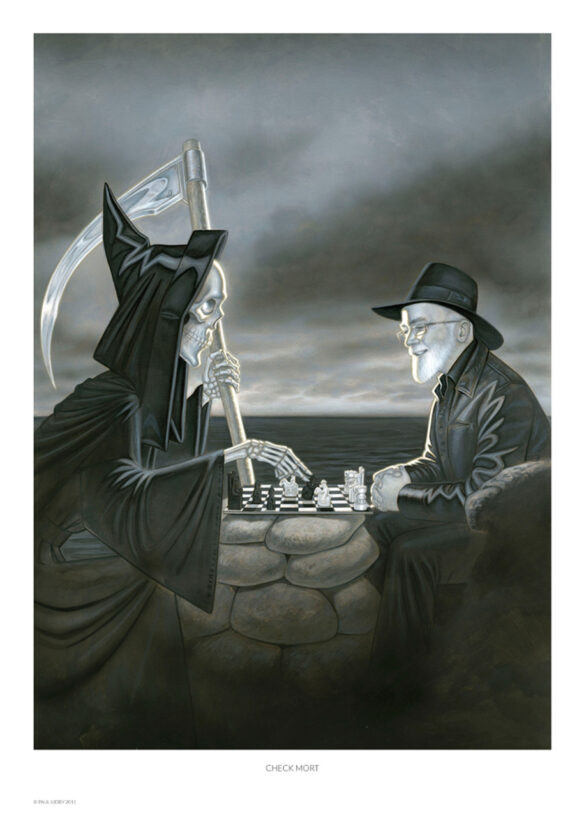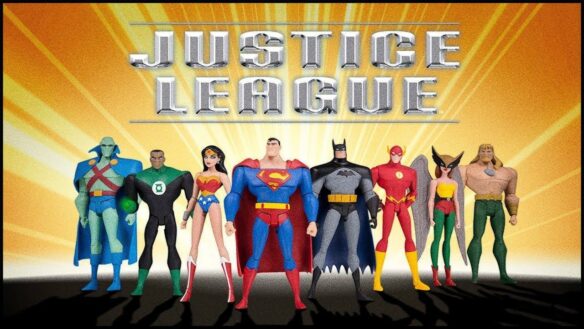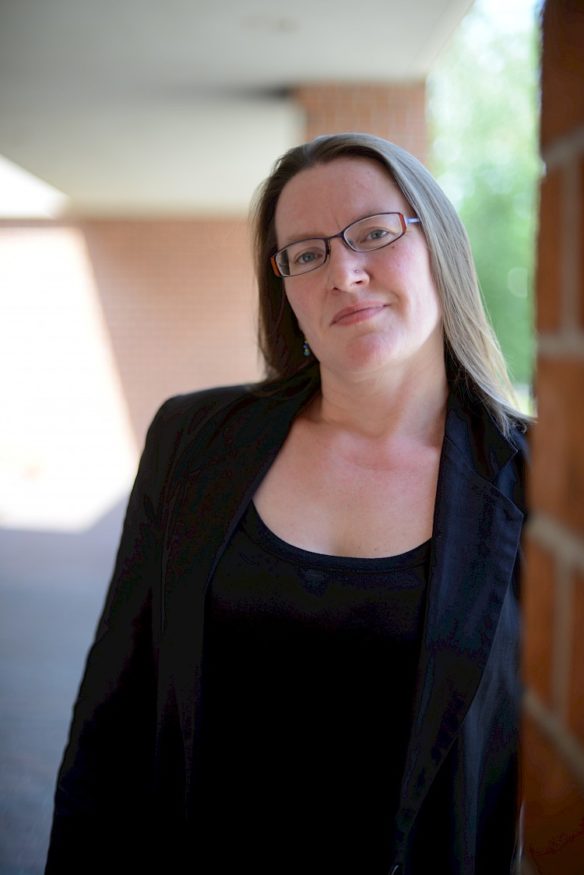(1) GUARDIAN BOOK REVIEWS. Past Best Fan Writer Hugo winner Abigail Nussbaum, and author of 2025 BSFA Award winner Track Changes penned the Guardian’s latest “The best science fiction, fantasy and horror – reviews roundup”. Nussbaum cover The Devils by Joe Abercrombie (Gollancz, £25), The Incandescent by Emily Tesh (Orbit, £20), Land of Hope by Cate Baum (Indigo Press, £12.99), and A Line You Have Traced by Roisin Dunnett (Magpie, £16.99).
(2) MEETING DEATH SCIENTIFICALLY. [Item by SF Concatenation’s Jonathan Cowie.] The BBC’s World Service has a nifty weekly science programme Unexplained Elements. This week’s programme was topical with this week’s news of the Pope popping off and the pomp and circumstance ceremony that garnered international attention. It was a topic in which the late Terry Pratchett would have been interested.
It addressed questions such as when did humans first start burying their dead? The answer seems to be over 100,000 years ago, but this is for anatomically modern humans. Apparently some proto-human species (whose brain capacity was a third of modern humans) may have buried their dead, though the research (currently in peer review) is debatable. Apparently, the pre-print has been amended to take criticisms into account and while one critic has been convinced, others remain sceptical.
Another topic was that of the biology of graveyards. Because its ground remains largely untilled, and because of gravestones and the like, there are many micro-environments, and both these factors lead church graveyards have a higher local area biodiversity.
Then there is the issue of a dead person’s digital rights to their social media and online accounts. The European Union’s GDPR is the world’s most robust data protection regulation, though that does not seem to stop firms like Facebook or EventBrite failing to strictly follow it (just look as the small print when you sign up) or even Worldcons who arguably (it would be interesting to test this in court and I could write an essay on this) fail to strictly adhere to its provisions. Nonetheless, despite GDPR being the world’s gold standard in data protection, the dead have no rights whatsoever under GDPR!
Talking of a dead person’s digital rights (or lack thereof), what of mobile (cell) phones and smartphones, what happens to them when they ‘die’? Well, fans of Red Dwarf might say that they go to silicon heaven. The reality, however, is for most of them landfill! Here there are multiple environmental sustainability issues. All those heavy metals and rare earth elements leech out in landfill causing threats to water tables and other ecotoxicology issues. And then there is the loss of these elements (which include silver and gold – many kilograms per tonne of mobile phones disposed) to the economy necessitating the mining of replacement elements and the environmental damage that this does. So the next time a Worldcon tells you that they are ditching recyclable paper from sustainably managed forests (look for the kite mark when buying the paper for publications) don’t accept the Worldcon’s word for it: more greenwash!
It was a fascinating programme. You can access it here.
First up, we delve into the thorny issue of when early humans started to carry out funerary rituals, before turning our attention to graveyards and the life that thrives within these sacred environments.
Next, we are joined Carl Öhman from Uppsala University in Sweden, who reveals what happens to our data when we die and why we should care about it.
Plus, we discuss the precious materials hiding in our old devices, and find out whether animals mourn.

(3) DODGE THE SCAMS. Victoria Strauss points out “Two to Avoid: Book Order Scams and Fake Reviews”. Full details at Writer Beware.
Here are two newish frauds that appear to be on the rise. As with most writing scams these days, they target self-published authors.
The Book Order Scam
I’ve written before about book order scams, in the context of scammers impersonating bookstores such as Barnes & Noble with out-of-the-blue emails promising bulk purchases and big royalties. All the author has to do is pony up thousands of dollars or pounds to cover printing and/or shipping costs (the relevant note here: bookstores do not print the books they sell, and they typically order from the publisher or publishing platform, rather than from the author).
This newer version of the book order scam is somewhat different, arriving not from a bookstore impersonator, but from the self-publishing service provider the writer has hired to publish and/or market their book. That provider isn’t a true self-publishing company, though, but rather one of the many ghostwriting scams that waylay would-be indie authors in order to defraud them….
Fake Reviews
Fake reviews–sometimes just a few lines, sometimes elaborate essays with stars and number rankings–arrive unasked-for, attached to a complimentary email claiming that a book has been “discovered” by book scouts or book evaluators. Or they’re included as part of a pitch for a package of publishing and marketing services, to show how much the service provider believes in the author’s book.
Undoubtedly produced by feeding book blurbs and other info into chatbots, they are essentially bait: affirmation and flattery designed to induce the author to reply, so they can be subjected to aggressive sales pitches for whatever the “reviewer” is selling.
Here are a couple of examples, both sent out by scammers on this list. They’re not just book reviews–they’re PROFESSIONAL book reviews! So much better than just the regular kind….
(4) CHERRYH ANNOUNCEMENT. CJ Cherryh told Facebook followers yesterday she and Jane Fancher won’t be at the Seattle Worldcon – but it’s not the result of any controversy.
Jane and I will not be attending WorldCon despite it being in our state (which some people might want to know)—no controversy, just the expense and the physical buffeting of crowds. While Jane’s got more go-juice than I do, the crowd pressure and distances involved would be pretty exhausting, leaving us sadly low-energy. We’ll still go to friendly ‘little’ cons in driving range, note well, if we know about them!!! and be our brilliant selves, but we’re not up to a full-on WorldCon.
(5) ABOUT THE FEMALE MAN. Farah Mendlesohn’s book Considering The Female Man by Joanna Russ, or, As the Bear Swore is available for preorder from Luna Press Publishing. It will be released in Summer 2026.
Joanna Russ’s writing career was relatively short, running from 1968 to 1987, with a number of essay collections published in the years after that. Her fiction career consists of just six novels and four collections, but each of the novels she published challenged engrained conventions of the genre.
The Female Man was received with shock, horror and vituperation when it was published in 1975. Its fractured narrative, and its direct attack on patriarchy and the straight-jacket of performative femininity, were described as shrill and man-hating. Over the years it emerged as a classic of feminist science fiction, a novel that continues to excite and resonate, and a touchstone for proudly militant feminists.
This exploration of The Female Man offers a close reading of the text, focussing on how the book works, its structures, arguments, humour, and brilliant anger
(6) COMPENSATING FACTORS. “My School Visit was Cancelled. I Fought Back and Won” writers Erica S. Perl in School Library Journal.
As a children’s book author, I love a good mystery. Which is why, last month, after a Virginia elementary school principal abruptly cancelled my visit by email, with no explanation or interest in rescheduling or paying me, I decided to investigate.
It didn’t take Sherlock Holmes to figure out what had happened: a parent had complained because of a social media video I had made celebrating Pride month. In it, I mention that Snail, a character in my Whale, Quail, Snail early reader series (illustrated by Sam Ailey), is nonbinary. Most snails are. “It’s a fiction series,” I add, “but that’s a fact.”…
… I wish I could tell you that my story ended amicably with the return of my visit to the school’s calendar. That’s not what happened.
Instead, after I asked for my fee, the principal turned the matter over to the district’s lawyers. The principal then informed the school librarian, who booked my visit, that she might have to pay me out of her own pocket. I told her I would not take her money, no matter what happened. I was extra-outraged that the principal was threatening to make her pay for the “crime” of setting up an author visit.
But my story doesn’t end there. I’m not just a children’s book author. I’m also a former trial lawyer. So instead of walking away muttering about injustice, I spent some quality time with my contract.
That’s right, my author contract. Whenever I am invited to visit a school, my booking agent draws up a contract—and this visit was no exception. According to one clause, if an appearance is cancelled with less than 30 days notice, the school is required to pay my entire fee plus any non-refundable travel expenses. The principal had cancelled on me 28 days before my visit.
And finally, my contract specifies that the contract is governed by the law of the state where I live, not the law of the state where the school is located. So if I wanted to sue for breach of contract, I could simply file papers in my local courthouse (no legal expertise or degree required!).
So, I did. Which is how I got to a different kind of happy ending: the school paid me my fee.
It’s not the win I wanted, because that would have had me standing in front of a gymnasium full of elementary school students. But it is a victory, as I see it, for all authors, especially in this current climate….
(7) KILLER ROBOTS NO LONGER SCIENCE FICTION. [Item by Francis Hamit.] “Unmanned Systems Are Not Revolutionary (But Could Be)” says a post on War Room, hosted by the U.S. Army War College.
Rather than revolutionizing warfare, unmanned systems have emerged as evolutions within the larger information revolution; advancements to be sure, but failing to render conventional militaries obsolete or dramatically reshaping force structures….
(8) PLONK YOUR MAGIC TWANGER. The one answer Smithsonian Magazine knows for sure is the price: “Who Created This Peculiar Painting of a Drooling Dragon? Nobody Knows—but a Museum Just Bought It for $20 Million”. Steven French adds, “Actually the ‘drooling dragon’ looks more like our Patterdale Terrier after he’s spotted the postman!”
Emma Capron, a curator at the museum who was responsible for the acquisition, describes the altarpiece as “wildly inventive” and “full of iconographical oddities,” per the Art Newspaper.
Start with the dragon and its bizarre dog-like face, exaggerated fangs and dripping drool. According to tradition, Satan, disguised as a dragon, swallowed St. Margaret whole. His stomach rejected her and there she appears in the painting, kneeling in prayer, totally unfazed by the event.Next to Margaret, one of the two angels holds a book of song, once thought to be a hymn by the English composer Walter Frye but now identified as musical gibberish. The other angel plucks her mouth harp, “a sound hardly associated with celestial harmony,” as the National Gallery says in the statement….
(9) PEACEMAKER IS BACK. “Peacemaker Season 2 Trailer: John Cena’s DC Superhero Returns” – Variety sets the frame.
… John Cena‘s very R-rated DC superhero has returned in the first trailer for “Peacemaker” Season 2, created by DC Studios co-chief James Gunn. The sophomore season takes place in the rebooted DC Universe, which officially kicked off with Gunn’s animated series “Creature Commando” and continues with his summer tentpole “Superman.” Nathan Fillion’s Guy Gardner and Isabela Merced’s Hawkgirl cameo in the trailer and will appear in “Superman.”…
(10) TODAY’S BIRTHDAY.
[Written by Paul Weimer.]
May 10, 1969 — John Scalzi, 56.
By Paul Weimer: I’d read John Scalzi’s blog for years before his fiction.
I got onto the Scalzi train with his entry in Metatropolis. His story involving a high tech pig farmer had all of the bones of a Scalzi story, from its “I think I know everything” protagonist, to its often snarky sense of humor. While I didn’t fall deeply in love with his work, then or since, I kept reading his work. Redshirts, of course, which still may be my favorite of his novels and stories, helped expand in my mind the metafictional opportunities in science fiction. Lock In is a solid piece of science fictional speculation on how a society might come together and respond to the consequences of a pandemic. Given that it was written long before Covid…I wonder if Scalzi or, aged fifty six yearswould have reconsidered the novel after the worldwide reaction to the aftermath of the Covid Pandemic.
Of course the Old Man’s War series is the one that he gets grief for, because it should appeal to the Sad and Rabid Puppies…but it is, in the parlance of today, “too woke”. It’s possible that the existence of such books helped motivate Torgersen and Beale, an irritant to their ideology and worldview (and a counterexample to the idea that Mil-SF must be conservative). Again, I do wonder how Scalzi would write it today, given all that has happened.
So this is a long way of saying that although it is on my Kindle, I have not yet read When The Moon Hits Your Eye, which seems to have as triggering an idea (the moon turns into cheese. Seriously?) as one can possibly make in the field. But it shows that in the end, Scalzi likes to have fun when writing. He never takes it too seriously, even if he keeps it as rigorous and locked down as the story needs. He’s just telling stories and doing his thing and having the time of his life, and haters can go hang.
The first time I actually met him in person, he didn’t remember it. He was extremely jet lagged, sitting in a hotel lobby and apparently remembered little from the entire weekend. Due to circumstance (although Scalzi is an excellent DJ, I am told, I am not a dance party goer), I only finally, finally actually got to talk to him at the Glasgow Worldcon. Being part of the photography team did let me meet and photograph everyone who would hold still. But did he know who I was? I’m still convinced that he didn’t, and that’s all right.
John Scalzi’s fiction, too…that’s all right.


(11) COMICS SECTION.
- xkcd offers another science fact.
- Baldo has help coming up with an excuse.
- Brewster Rockit creates fan fiction.
- Lio finds something waiting.
- Reality Check tries a pun.
(12) AMAZING STORIES COLLECTION. Amazing Stories: Best of 2024,a collection of science fiction short stories published by the magazine over the past year, is now available.
Edited by Lloyd Penney, this collection continues Amazing’s nearly century-long tradition of exploring the strange, the speculative, and the sublime.
From lunar labor revolutions to delicate alien diplomacy, these stories represent the vanguard of speculative fiction. Readers will encounter futures both dystopian and dazzling, technologies that reshape identity and time, and characters grappling with the emotional and ethical consequences of scientific progress. Highlights include:
- “A Short-Lived History of the Stockpiling of Time, in Post-Mono-Heliocentric Space-Times” by K.V.K. Kvas, a mind-bending tale of interstellar economics, identity, and revolt.
- “Return from Venus” by C.B. Droege, a quiet and touching story about cross-species friendship and the longing for home.
- “Best Case Scenario” by Susan Oke, a suspenseful diplomatic mission where what you offer—and what you misunderstand—could mean the difference between peace and peril.
With cover art by Hugo Award-winning artist Bob Eggleton and a lineup of diverse voices offering everything from hard science speculation to lyrical philosophical fiction, Amazing Stories: Best of 2024 is a must-have for any SF fan’s collection.
“Amazing Stories has always been a home for bold, boundary-pushing science fiction,” says Editor-in-Chief Lloyd Penney. “This year’s stories continue that proud legacy—with some of the most challenging, beautiful, and entertaining tales we’ve ever published.”
It is available online at amazingstories.com and in paperback and eBook editions at indie and major retailers worldwide or at this link.
(13) MONSTROUSLY COOL. That’s what your drinks become with an assist from the “Godzilla Ice Mold”.

(14) DAISY RIDLEY’S ZOMBIE ENCOUNTER. JustWatch quotes Daisy Ridley in its Why to Watch feature about her role in the zombie thriller “We Bury the Dead streaming: where to watch online?”
We Bury the Dead is a gripping, emotional thriller set in a world transformed by the undead. In a unique take on the zombie genre, the film follows Ava—a woman tormented by loss—who volunteers with a corpse retrieval unit to search for her missing husband. Set against a surreal yet intimate apocalypse, the story explores love, grief, and the fragile boundaries of what makes us human.
Daisy Ridley says:
The script is beautiful. It’s about grief and watching someone desperately trying to find an answer, even though she doesn’t know what that answer is going to be. The backdrop of the zombies represents this moment for [my character] Ava because she’s neither here nor there emotionally. Ava’s sole purpose is to find her husband. As a means to get to him, she joins the body retrieval unit which volunteers to find people and notify families. The zombies look like our friends and family, so it’s close enough to reality but in a way that doesn’t feel too close. It feels horribly human.
(15) HONEY, I’M HOME! “Soviet-era spacecraft Kosmos 482 plunges to Earth after 53 years stuck in orbit” reports AP News.
A Soviet-era spacecraft plunged to Earth on Saturday, more than a half-century after its failed launch to Venus.
Its uncontrolled entry was confirmed by both the Russian Space Agency and European Union Space Surveillance and Tracking. The Russians indicated it came down over the Indian Ocean, but some experts were not so sure of the precise location. The European Space Agency’s space debris office also tracked the spacecraft’s doom after it failed to appear over a German radar station.
It was not immediately known how much, if any, of the half-ton spacecraft survived the fiery descent from orbit. Experts said ahead of time that some if not all of it might come crashing down, given it was built to withstand a landing on Venus, the solar system’s hottest planet.
The chances of anyone getting clobbered by spacecraft debris were exceedingly low, scientists said….
…Any surviving wreckage will belong to Russia under a United Nations treaty….
…After so much anticipation, some observers were disappointed by the lingering uncertainty over the exact whereabouts of the spacecraft’s grave….
A Russian press release says it fell in the Indian Ocean west of Jakarta.
(16) YOUR ALIEN NATION. The BBC explains, “More than half your body is not human”.
More than half of your body is not human, say scientists.
Human cells make up only 43% of the body’s total cell count. The rest are microscopic colonists.
Understanding this hidden half of ourselves – our microbiome – is rapidly transforming understanding of diseases from allergy to Parkinson’s.
The field is even asking questions of what it means to be “human” and is leading to new innovative treatments as a result.
“They are essential to your health,” says Prof Ruth Ley, the director of the department of microbiome science at the Max Planck Institute, “your body isn’t just you”….
… But genetically we’re even more outgunned.
The human genome – the full set of genetic instructions for a human being – is made up of 20,000 instructions called genes.
But add all the genes in our microbiome together and the figure comes out between two and 20 million microbial genes.
Prof Sarkis Mazmanian, a microbiologist from Caltech, argues: “We don’t have just one genome, the genes of our microbiome present essentially a second genome which augment the activity of our own…
(17) SCIENCE PAPERS WITH UNDISCLOSED AI USE. [Item by SF Concatenation’s Jonathan Cowie.] Artificial Intelligence (A.I.) is controversial to some, in no small part due to large language models (LLMs) and other A.I. (such as image-generating A.I.) using people’s intellectual property (their written or art works) for A.I. and LLM training without permission or recompense. This is exemplified by the recent debate over the Seattle’s Worldcon use of A.I. (for example, see (1) in the Scroll here).
Similarly, the use of A.I. has controversies in science. Indeed, a number of leading science journals, such as Nature, frown on the use of A.I. and/or at least ask science authors to declare any use of A.I. in their submissions. The latest news here comes from a news item in this week’s Nature that hundreds of papers have used A.I without disclosure!
Generative A.I. tools such as ChatGPT have quickly transformed academic publishing. Scientists are increasingly using them to prepare and review manuscripts, and publishers have scrambled to create guidelines for their ethical us. Although policies vary, many publishers require authors to disclose their use of A.I….
But science sleuths have identified hundreds of cases in which A.I. tools seem to have been used without disclosure…
…Publishers need to act quickly to resolve issues of dishonest A.I. use.
[Thanks to Teddy Harvia, Mike Kennedy, Andrew Porter, Rich Lynch, Paul Weimer, Francis Hamit, John King Tarpinian, Chris Barkley, Cat Eldridge, SF Concatenation’s Jonathan Cowie, Mark Roth-Whitworth, Steven French, and Kathy Sullivan for some of these stories. Title credit belongs to File 770 contributing editor of the day Xtifr.]






































